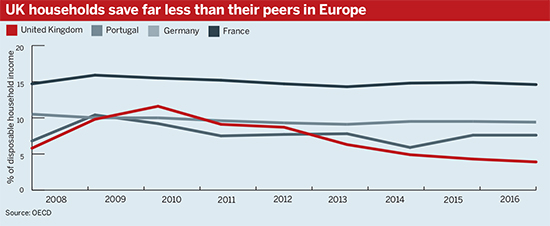Analysis: The introduction of a workplace Isa, mooted in a new proposal this week, could present both the UK workforce and employers with a radical new alternative, but how can developments in government policy drive the sea change needed in the UK’s savings culture?
As the rarest animal in all of Africa, successful capture of the ‘push-me-pull-you’ promised riches aplenty for Dr Dolittle’s contemporaries; with a head at each end and sharp horns, the push-me-pull-you was, by nature, a headstrong and wilful beast.
Surrounded by incentives to spend, UK consumers must be similarly wilful in their decision to save. At one end, UK employees have been legislated by the Department of Work and Pensions to save via auto-enrolment. However, with HM Treasury at the other end, pushing change across UK pensions to drive tax receipts, British savers could be left confused about their savings options.
Crucially, the individual is in control – not the industry
Michael Johnson, Centre for Policy Studies
Tax incentives
Traditionalists in the UK pensions industry rally behind tax relief as a key incentive to save into pensions, but research conducted in Denmark by Harvard University has shown that automatic contributions are more effective in increasing saving rates than tax subsidies.

In their report, ‘Active vs. Passive Decisions and Crowd-out in Retirement Savings’, Harvard researchers examined Danish tax records and concluded that every $1 (70p) spent on tax relief on pensions had led to just 1 cent of extra saving.
Moreover, researchers found relatively few individuals respond to tax incentives – which do not increase the savings of passive individuals, who are least prepared for retirement.
But the broader outlook for UK savings, beyond those least prepared for life post-work, looks bleak as well.
The latest figures from the OECD forecast the 2016 gross UK savings rate at 3.9 per cent of disposable household income, down from 11.6 per cent in 2010.
Relative to their European peers, UK savers lag well behind the French, who are expected to save 14.6 per cent of income this year and Portugal, at 7.6 per cent.
Chancellor George Osborne had a crack at reversing the trend of undersaving in March’s Budget announcement, with the addition of the Lifetime Isa to the UK saver toolkit.
Available to under-40s only, with an annual savings limit of £4,000, contributions into the Lisa will be topped up by the government at a rate of 25 per cent, or £1 for every £4 put in – an architecture first mooted by Michael Johnson, research fellow at think-tank the Centre for Policy Studies.
Savings in the Lisa can be accessed penalty-free from age 60, but, crucially, are accessible during the savings phase for buying a first home worth up to £450,000.
Savers’ choice
Before the end of March, the Work and Pensions Committee reopened its inquiry into auto-enrolment to receive submissions on the potential impact of the Lisa’s introduction on auto-enrolment, which could be seen as an alternative to saving into a workplace pension.
The chance of savers favouring the Lisa over workplace pension schemes may be over-egged; research commissioned by Now Pensions and carried out by Opinium found just 9 per cent of savers would leave their workplace pension in favour of the Lisa.
But with HM Treasury behind the Lisa in one corner and the DWP backing pensions in the other, it is easy to see how savers might be pushed and pulled in different directions.
Insurer Royal London called for action to protect auto-enrolment legislation from being undermined by the Lisa, in a submission to the government last week.
The insurer has proposed a new requirement for the under-40s to have access to impartial guidance before making choices about workplace pensions and Lisas, alongside an additional rule compelling those under 40 to take full advantage of employer contributions associated with a pension before considering contributing to the Lisa.
Definitively, Michael is wrong
Henry Tapper, First Actuarial
Johnson poured fuel on the industry fire last week in a new paper laying out his latest vision: the Workplace Isa.
In the proposal, Johnson casts the Wisa as an inner chamber located deep within the Lisa, which will receive employer contributions under the same Lisa framework, but will be locked up until savers hit 60.
Johnson says it is not his intention to replace the pensions system with Isas, but rather, that the Wisa be installed as a viable alternative savings vehicle on offer for consumers.
Employees’ auto-enrolment contributions must be “personable, visible and accessible” Johnson says, acknowledging that at certain points in life savers need more flexibility. “We’d like to discourage people from accessing their own auto-enrolment contributions but recognise there are situations when they are desperate,” he says. “Crucially, the individual is in control – not the industry.”
Johnson says the Workplace Isa will offer consumers choice about where they wish to direct their employers’ contributions.
“I’m not out to ban this or ban that – this is something I think a lot of people will find attractive,” he says.
Johnson acknowledges that reception of the Lisa, rolled out from April next year, will influence whether the Wisa concept is taken up, but views the new framework as “seminal in moving away from the traditional rigidity of the pensions architecture”.
The introduction of pension freedom has removed the government’s reason to continue providing tax relief on pension contributions, he says, first awarded to recognise a long-term commitment to saving.
“The really dramatic change in this whole landscape is the introduction of freedom and choice,” Johnson says. “It begs the question: what is tax relief for?”
“Huge problems”
Francois Barker, head of pensions at law firm Eversheds, says the introduction of “lots of new options” risks causing confusion and a reduction in the overall levels of savings.
Lifetime Isas could play a role in supplementing pension saving if they prove popular, he says, but adds there is no need for a Wisa to achieve this result.
“We are concerned that savers would be worse off under the Wisa model, as they would be taxed on their employer contributions and would only receive the equivalent of basic rate tax relief,” he says.
“They would also be reliant on future governments resisting the temptation to tax Wisa savings on exit or during the accumulation phase.”
Henry Tapper, director at consultancy First Actuarial, says he has no wish to fall out with Johnson, but that “definitively, Michael is wrong”.
Tapper says the introduction of the Wisa would present “huge problems” for employers, payroll and long-term investment strategies – with Lisa savings targeting both house purchases and retirement incomes.“It’s too difficult and hard for ordinary people and ordinary employers,” he says.
Tapper supports reform of current tax incentives, however.
“For people in their 20s tax relief is not the be-all and end-all,” he says. “What we put in place as a tax incentive system cannot be based on what has gone on in the past.”
For Johnson, resistance to change will only increase the likelihood of digital disruption by the likes of Apple or Google.
“A digital disruptor is going to walk in and shock everyone out of their stupor,” he says.














